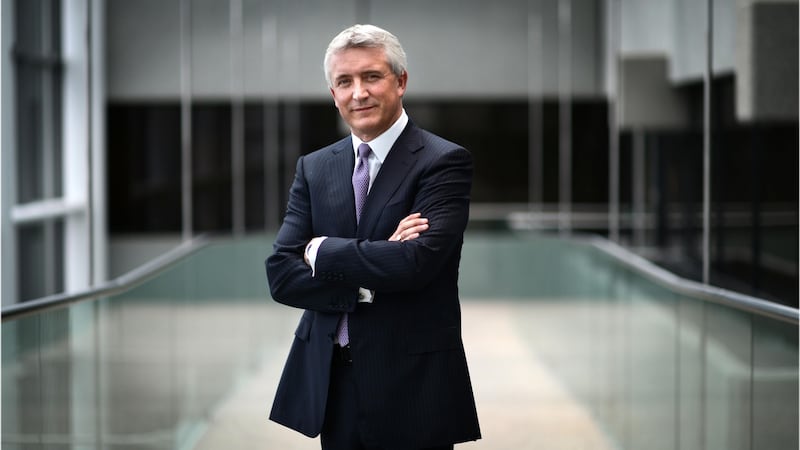August 2008: AIB reports a €1.28 billion pretax profit for the first half of 2008. Pays €270 million dividend to shareholders as most other banks globally are saving money to deal with the impending financial crisis.
September 2008: Government issues controversial bank guarantee covering AIB and the State's five other main domestic lenders. Irish financial industry teetered on brink of collapse after Wall Street bank Lehman Brothers collapses.
October 2008: AIB chief executive Eugene Sheehy rules out bailout, saying "We'd rather die than raise equity".
December 2008: Government concludes that banks need to be recapitalised to prevent them from imploding.
March 2009: AIB reports loss for 2008 in its unit in the Republic, the first since group was set up in 1966.
May 2009: Sheehy, finance director John O'Donnell, and chairman Dermot Gleeson quit as taxpayers prepare to inject initial €3.5 billion into ailing lender.
March 2010: AIB ordered to raise €7.4 billion after first round of stress tests carried out by Central Bank; Nama starts to take over toxic commercial property loans from nation's banks. AIB ultimately transfers €20 billion.
September 2010: AIB agrees to sell Polish unit Bank Zachodni WBK (considered the jewel in its crown) to Spain's Santander to raise €2.5 billion of capital. The Central Bank says AIB needs additional €3 billion – two months after bank passes European stress tests. Group managing director Colm Doherty and chairman Dan O'Connor signal they will step down.
October 2010: AIB raises $2 billion (€1.4 billion) from sale of its 22.4 per cent stake in American lender M&T Bank.
November 2010: AIB reveals its reliance on emergency Central Bank funding has tripled in five months to €27 billion as companies and customers pull money amid worsening crisis. The Government agrees to €67.5 billion international bailout as soaring cost of rescuing the banks become too much for State to handle.
December 2010: State takes control of AIB two days before Christmas after receiving court approval to pump €3.7 billion into the company. AIB, which first listed in 1967, is relegated to junior stock market in Dublin as only 0.2 per cent of stock remains in private hands.
January 2011: AIB sells Goodbody Stockbrokers to Kerry-based financial services group Fexco for €24 million.
March 2011: AIB records €12.1 billion pretax loss for 2010 and is ordered to raise €14.8 billion after round of banking stress tests ordered by the bailout troika. New minister for finance Michael Noonan directs AIB to take over EBS Building Society.
July 2011: AIB bailout bill peaks at €20.8 billion and bank completes two-year process of inflicting €5 billion of losses on junior bondholders.
August 2011: AIB's market value soars to €62 billion – three times its pre-crisis peak of February 2007 – making it notionally Europe's fifth-largest bank, as some speculative investors ignore the fact that only 0.2 per cent of the bank is out of State hands. Noonan subsequently warns repeatedly that the bank is "overvalued".

December 2011: AIB appoints Irish man David Duffy, a former executive at South Africa's Standard Bank, as chief executive.
March 2012: AIB unveils plans to cut 2,500 jobs.
October 2012: AIB chief executive David Duffy says bank aims to be ready to return to private hands within two years (2014).
February 2013: Noonan moves to phase out bank guarantee scheme, saying nation's banks have "moved out of the emergency ward".
June 2013: AIB's level of soured loans peaks at €29.2 billion – or 34 per cent of its total book.
January 2014: Noonan rules out reintroducing bonuses after AIB approaches minister about setting up an incentive plan to retain top executives. "The answer is, 'Sorry guys, much better performance required before we'll even consider [bonuses]," he said.
May 2014: AIB wins EU approval for its State-aid restructuring plan.
June 2014: AIB's chairman, David Hodgkinson, says bank will repay its entire bailout bill in time.
October 2014: Noonan pulls back on campaign to pass on part of cost of AIB bailout to euro-zone bailout fund, saying taxpayers "may do better" selling its shares in the market.
December 2014: Briton Richard Pym takes over from Hodgkinson as AIB chairman.
January 2015: David Duffy announces he's leaving AIB to join Glasgow-based Clydesdale Bank, now known as CYBG plc.
February 2015: Noonan says October 2015 earliest "window" for AIB initial public offering (IPO).
March 2015: AIB reveals it swung into a €915 million profit in 2014 as it begins to free up money previously set aside to absorb bad loans.
April 2015: Former AIB chief executive Eugene Sheehy tells Oireachtas banking inquiry that his failure to hand over the bank in good shape to his successor is "a matter of eternal regret and sorrow". However, there was "absolutely no issue of AIB's solvency" on night of the guarantee.
May 2015: AIB names Bernard Byrne, head of retail and business banking unit, as chief executive.
July 2015: Minister for finance Michael Noonan says IPO may take place in mid-2016.
December 2015: AIB begins to repay its bailout, redeeming €1.7 billion of preference shares issued to the State during the crisis.
July 2016: AIB repays a further €1.6 billion to State, redeeming so-called contingent convertible notes.
August 2016: AIB and Bank of Ireland fare among the worst in European Union banking stress tests.
December 2016: AIB admits about 3,000 of its customers had been wrongly denied a tracker mortgage rate over past decade, as Central Bank oversees an industry-wide review of overcharging on home loans. Bank sets aside €190 million to cover cost of tracker issue.
March 2017: AIB pays State almost €280 million in first dividend in almost nine years, after posting €1.7 billion pretax profit for 2016.
May 2017: State announces intention to sell initial 25 per cent stake in AIB, which may raise up to €3 billion.






